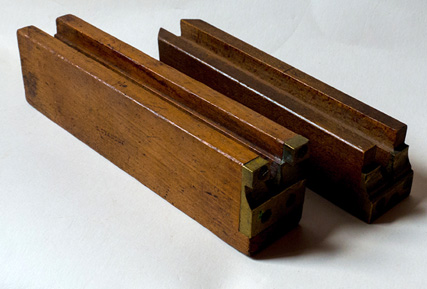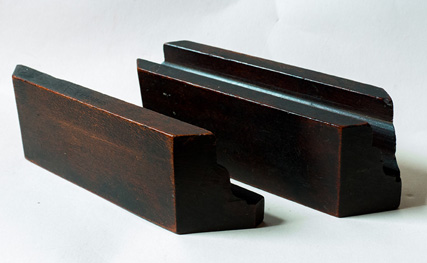
For some time now, I been drawn to the idea of making traditional box sash windows using mainly hand tools. By ‘traditional’, I mean sticking the mouldings of the glazing bars with sash planes, rebating the stiles and meeting rails and chopping out all the mortise and tenons by hand.
One thing that has always confused me. Even though I have now found some excellent sash planes, I still wondered how craftsmen used to mitre the cross joints so accurately.
During bits of research on the internet, I’ve come across some excellent resources, such as this pdf from Tim Nott.
However, some tools that kept cropping up in 18thc-19thc information, was the use of sash templates, or ‘templets’. I sent a query to Brian Read at the excellent Tools and Trades History Society, asking of he knew of anyone who could show me how to use these and perhaps I could photograph a slideshow. (This enquiry applies to anyone else who also happens to read this post. I live in London and would still very much like to watch a joiner who can show me these in use.)
Brian was very helpful and forwarded my request to Jane Rees, who many readers will be familiar with, from her and her late husband’s excellent books about vintage tools.
Jane came back with some great info. To start with, if you were making sash using a template, you would have been expected to have a matching plane, to make a perfect profile to drop into the template. This I didn’t know.



Jane supplied me with some of her pictures showing a matched plane with template, some templates of different styles on their own and also a superb pdf of an article Jane wrote for the Construction History Society (which was later reprinted by the Early American Industries Association). You can download a pdf of the article here (3.22mb).
Once you have a profile that has been cut to for the inside of your template, you can work on mitring, or coping the end of it. Mick Dowling of the HTPAA shed some light on this for me:
The components of a sash are the top and bottom rails, the left and right stiles, and the glazing bars.
If you look at a sash from within the building the intersections of the
moulded part of these components (the fancy shaped bit, lambs tongue for example) appear to be mitred, but are in fact coped. Similar to the way the intersection of skirting boards (the board in a room at the base of wall) in an internal corner looks to be mitred, but is one piece of timber cut to fit (coped) over the adjacent piece.
Coping is particularly the case where glazing bars meet the stiles or rails.
I’ve worked on windows as old as the 1860s and have seen stile/rail
intersections that are simply mitred.
Scribing templates are either double sided to fit over the glazing bar, or
single sided for use on the stiles or rails.
With either of those types there are 2 variations. The ones with brass tips
are square on the end and are used with a coping chisel, and the type that is cut on a 45 is used for marking with a pencil or scribe and cutting out the waste with a coping saw.
Sometimes the single sided ones are screwed together to make a template that fits over the glazing bar. Might have been made that way.
If you’re slightly confused about glazing bars and which way round they face, take a look at an excellent write-up on Zach Dillinger’s blog. He shows you how a sash fillister is used when working on the outer rebates where the glazing would sit. A great page which will explain things much easier than I could do!
(Added 05/10/2014)
David Nelson, a reader of the blog from the US, has kindly sent me a digital copy of his excellent guide ‘English Sash Planes’ and kindly allowed me to add a link to the blog for people to download it. Well worth a read.

You can download a pdf of the article here (11.37mb).

5 replies on “How to use sash templates, or ‘templets’”
What a brilliant blog post. Many thanks Gary for bringing together some of the few bits of written information on this subject. So hard to research when all the written resources are from later, when multiple panes with intersecting glazing bars were no longer the norm.
Sash making must have been exactly the sort of work where every efficiency really mattered, when you think of the millions of windows made with hand tools.
Extra thanks for putting a pdf of Jane’s article online – I knew it existed but had not found a complete copy.
Hello Gary,
I have started taking photos of my sash tool collection. I will send a photo of my sash coping and sash pocket chisels. I thought that I could use the Mathieson catalog to determine the profiles on my planes, shaves and templates. i went ahead and started making some sash bars and found that I needed to actually make the items to see how they matched the catalog. I have the green catalog by the way. I also found an article that I wrote for a display at a local tool collector’s show. I will scan that and forward it to you.
We had a member, James Patterson, in our tool collectors club who was making wooden windows in Scotland up until 1960’s when he decided to come to the U.S. One of the processes he described to my was “Frenching” the window sash. This involved using square bamboo pegs rather than a mortise and tenon. The fibers in the bamboo held the bars in place without glue. I made a fixture for producing the bamboo pegs as part of the display for the tool show.
Regards, Dave Nelson.
Dear Gary
I just read your very interesting article “How to use sash templates, or ‘templets’”.
I’m very interested in in old woodworking process and making windows with hand tools is a part of my interests.
David Nelson wrote as a comment, he was starting taking photos of his tool collection, especially of his sash coping and sash packet chisels.
Did David ever make the photos? Did he make an article around this subject? Do you know about his activities?
Yours, Josef Marti
Hello all,
I was looking for information sash coping chisels when I ran across this blog.
I am going to sell most of my sash making tools. I will be photographing the collection over the next few weeks. The collection includes about 12 matched pairs of molders, various templates and some auxiliary items. I have put together 47 planes for a package. I will be adding some additional items to the package in the next couple of days. I can provide a list it you want one. I also made reproductions of several sash doweling boxes. You can see the sash doweling boxes and my reproduction of the Seaton Chest at wkfinetools.
H David
You commented on this original post and kindly supplied me with your pdf for download on same page?
best
Gary